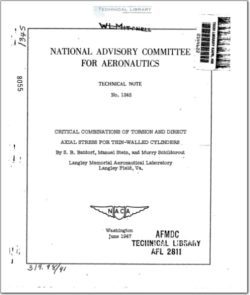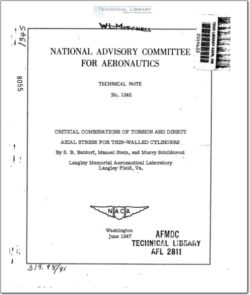NACA-TN-1345

- Version
- 545 Downloads
- 998.94 KB File Size
- 1 File Count
- December 4, 2015 Create Date
- December 4, 2015 Last Updated
National Advisory Committee for Aeronautics, Technical Notes - Critical Combinations of Torsion and Direct Axial Stresses for Thin-Walled Cylinders

A theoretical solution is presented for the determination of
the combinations of direct axial stress and torsion which cause
thin-walled cylinders with either simply supported or clamped edges
to buckle. This theoretical solution is used in conjunction with
available test data to develop empirical curves and formulas for use
in design. Comparisons are made -with'theoretical and empirical
solutions obtained in other investigations.
The determination of the combinations of direct axial stress
and torsion which cause thin-walled cylinders to buckle is treated
in the present paper. Cylinders in torsion buckle at a stress
slightly less than the theoretical stress (reference 1) and cylinders
in compression buckle at a stress considerably less than the
theoretical stress (reference 2). It therefore appears that the
theoretical solution would be in good agreement with the experimental
results when the buckling is due mainly to torsion but would require
modifications when the buckling is to any appreciable extent due to
compression.
Empirical approaches to the problem have been made previously
(references 3 to 5) and interaction formulas have been proposed for
use in design. 'Ihese formulas are somewhat limited as to the range
of applicability because of the limited range of dimensions of the
test specimens.
In the present paper theoretical interaction curves are derived
(appendix A), the test data of references 3 to 5 are re-enamined,
and finally empirical interaction curves and formulas that are
rational modifications of the theory are developed. The present
results can therefore be used over a much wider range of cylinder
dimensions than could previously available results. In the analysis
given herein the" theoretical results are first described and then
modifications are introduced to bring the results into agreement with
available experimental data.
| File | Action |
|---|---|
| naca-tn-1345.pdf | Download |

Comment On This Post